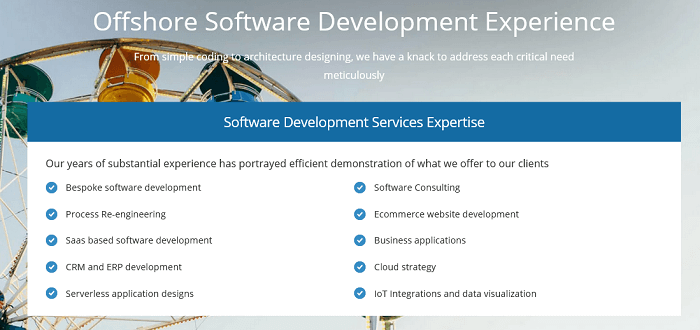Managing an Offshore Software Development team is not much different than maintaining the balance between two boats leading in the same direction in the middle of high oceanic waves. Nonetheless, there are certain factors to keep in mind while managing and leading a large offshore development team that is located thousands of kilometers away.
Nations typically provide offshore or Outsourcing services with significantly cheaper labor costs than the country receiving the services, which is tremendously profitable for the information technology industry. Thus, opting for reliable service providers could be the best match for your Offshore Software Development requirements. Also, take a look at the image below, focusing on the different kinds of expertise that you should expect from your provider.

As per Statista, the IT outsourcing business will be worth more than $413.7 billion by the end of 2021. It’s unsurprising, given that an increasing number of businesses have expressed an interest in performing services in other countries in recent years.
Thus, in this article, we will examine techniques to improve the management of offshore development teams and analyze the value of software outsourcing to your firm.
Types of Offshore Development Teams
Businesses considering IT staff augmentation services typically consider one of three models: an extended team, a managed team, and an outsourced workforce. The primary distinction between them is in the initial customer requirement and the extent to which the client delegated project management to a vendor.
- The extended team model enables the client to augment their existing development capacity while maintaining complete control over product development and team management. As a result, businesses frequently seek team extension services. This approach is optimal for short-term collaboration when it is necessary to scale a project and produce a product on time rapidly.
- For long-term projects, the managed team approach is ideal. A vendor establishes a dedicated development team that shares risk and accountability for the project’s outcome. They operate independently of the client’s in-house team but report to the client’s product owner. Numerous businesses have realized the benefits of establishing a specialized development team: cost-effectiveness, flexibility, ease of scalability, transparency, and seamless communication, to name a few.
- Outsourced teams are the most traditional form of collaboration. A vendor is entirely responsible for assembling the team and delivering the solution on time, from product discovery through final release. The client contributes ideas and specifications, and the vendor creates a custom solution that satisfies the client’s business objectives.
If you’re considering outsourcing software development services, you have three options: an extended team, a dedicated team, or an outsourced team. The fundamental distinction between them is in their approach to project management.
Problems faced by the Businesses during offshore software development
It might be challenging to manage offshore software, development teams. There are numerous factors to consider beforehand. Communication issues are almost certainly the most prevalent.
Let’s have a look at them all.
High Staff Turnover
Managing a team where specialists come and go regularly is not easy. In addition, due to the fact that each new team member must be onboarded, this results in development delays.
How to solve it?
When selecting a software development vendor, you should consider the HR brand. It would help if you determined whether the employees operate in a pleasant setting, have access to necessary equipment, and have ample self-development opportunities. If the vendor you’ve picked has a low turnover rate, this indicates that employees are content with their working conditions.
Loss of Product Knowledge
There are numerous modes of knowledge transmission. It can be performed between a client and a vendor and between team members working on the same project to prevent knowledge from escaping. In any case, unshared information is costly. When an entire process is redone from the start, knowledge loss leads to significant organisational waste. If your vendor has a high turnover rate and lacks a robust knowledge transfer strategy, you may experience slow team velocity, which could result in severe project delays.
How to solve it?
It is critical to ascertain whether a vendor prioritises knowledge transfer and is capable of implementing an efficient knowledge transfer strategy. You can determine how quickly your team was able to get started on the project: grasping the product and its associated processes, setting up the Development, QA, Staging, and Production environments, and gaining access to team-wide systems for the purpose of deploying releases and debugging. Notably, the smallest time period necessary to successfully complete the knowledge transfer process from the customer to the vendor is no less than one successful deployment into production by a new team.
Additionally, the vendor must value the knowledge-sharing culture of your project. There are numerous methods for knowledge transmission within a project, including regular Q&A sessions, live training, one-on-one meetings, tech presentations, and coffee breaks.
Cultural Differences and Ethics
Traditional and customary conflicts amongst corporate members are unavoidable. Managing teams comprised of members who grew up in disparate environments might have an effect on the workplace dynamics.
Once these distinctions become cultural barriers, they should be identified immediately. Even the tiniest cultural difference can greatly impact workplace relationships – from fundamental civility to how work is performed.
Vietnam, for example, has a moderate level of linguistic proficiency. While this is an excellent score, the metaphors and other cultural references may be lost on Vietnamese natives. This can easily result in misunderstandings.
How to solve it?
- Simplify your communication channels.
There is a greater likelihood that employees of the offshore team located in another country will not be fully fluent in your language. The best course of action is to utilise simple words and to be succinct. Avoiding analogies and being very specific with directions will also aid in this process.
- Conduct a culture raining session for both the domestic and international teams.
This will assist both the offshore and onshore teams in gaining a better understanding of their respective cultural practices and values. Conducting training and seminars can also assist in identifying each team member’s communication style. This can help avoid future misunderstandings.
Communication issues
Numerous businesses express concern about the language barrier and communication difficulties. If you and your team are located on separate continents, a time zone gap will exist. Inadequate communication can result in project delays and misunderstandings of project objectives and requirements.
How to solve it?
The solution is straightforward – you should organize meetings in advance. There are numerous communication technologies available, such as Slack, Skype, and Gmail, that will enable you to stay connected and track the development process.
Concerning the language barrier, it is a thing of the past, as most IT professionals speak fluent English.
Managing a Team of Offshore Software Developers
Product Vision Sharing

Its believed that many people simply give simple tasks to offshore developers without discussing the larger picture. Make the mistake of not providing them with the complete product concept.
All developers must comprehend the project’s objective and direction. Therefore, create a mental image for them of your product vision so they can make informed decisions while they work on the project.
Additionally, they must comprehend and be able to see forthcoming task items. They want to know that their jobs are secure and that the project is on track. Make certain you include specifics about release and sprint planning in your communication with them.
Time Difference Factors
Time zone differences can occasionally be a hindrance when working with distant teams. However, by utilising overlapping hours, this difficulty can be mitigated. For instance, when offshore to India, the mid-day mark of the Indian shift may coincide with the commencement of the UK shift.
That is why it is critical to plan for the shift in working hours. Your offshore crew may be up to 15 hours ahead of you, and by accounting for this time difference, you can create a more effective timetable for both your local and offshore employees. Coordinate meetings, scrum calls, and weekly catch-up conversations to ensure that the time difference does not harm communication between your teams.
Clear Communication

Naturally, contact with your offshore crew is important to the success of your project. However, the language barrier might make it difficult to communicate responsibilities to your employees, particularly those who are not native speakers of your original language.
Utilize applications designed specifically for this purpose, such as Outlook emails, Skype, or Zoom. That is an efficient and effective communication method with your engineers and obtaining clarification when spoken communication was unclear.
As a result, you can quickly track progress and always alert the offshore software development team to crucial issues.
Additionally, it is good to schedule regular meetings for Q&A sessions during the project’s completion. This advice can significantly increase workflow performance, resulting in faster and more accurate completion of the project.
Collaboration Tools
The most typical issue encountered by offshore development teams is that remote software developers are unable to grasp the project’s central concept and solutions. One of the primary reasons it appears is that the development environment is inconsistent between teams.
As a result, you may encounter low-quality software, delayed bug discovery, and a laundry list of essential integration difficulties.
All remote developers must utilize the prescribed software development, control, and improvement tools to address this issue.
This will assist you in ensuring that all critical processes are completed in accordance with the project plan and will substantially assist you in managing an offshore development team efficiently.
Regular Meetings
When managing offshore development teams, it is critical to maintaining frequent contact. Numerous tools exist to facilitate team communication:
- Slack
- Gmail
- Outlook
- Skype
- Hangouts on Google
- Zoom
You should establish a timetable for meetings with your development team. For instance, you can schedule a weekly video meeting with a Project Manager. You can ask questions regarding the development or offer adjustments and improvements during this conference. On the other hand, the Project Manager keeps you informed about the project’s progress and addresses any potential concerns.
You can arrange meetings with offshore development team members as a whole (designers, developers, QA engineers, and the Project Manager).
Additionally, you can pay a visit to the staff at their office. You can fly to the development team’s location. This enables you to communicate directly with your staff.
Treat Offshore Team as Partner
The offshore software development companies with which you choose to collaborate is much more than a service provider. If you’re serious about establishing and maintaining a greater level of collaboration, it’s time to set aside the hierarchy and approach them as partners.
Avoid Micromanagement

Nobody enjoys being micromanaged. It’s also difficult to scale your development team if you can’t empower and trust them to complete the necessary work. A capable senior developer must lead your offshore team.
If you’re having difficulty getting things done properly, determine whether your offshore staff is lacking senior leadership. Numerous businesses make the error of attempting to recruit a slew of inexpensive developers.
It is in both your and your offshore partner’s best interests to guarantee that your offshore workforce is capable of self-management and success. Ascertain that you have the appropriate mix of senior developers and, if necessary, a project manager.
Conclusion
When you approach your offshore software development staff as an extension of your business, on the other hand, they will go the extra mile for you. Even if it’s as basic as ensuring that their hours coincide with yours or adjusting their shift to accommodate your schedule, they’ll make it happen. Recognizing the team’s time, effort, and technical talents in developing software, spending time with them to get to know them better, and soliciting their feedback on improving the program can significantly strengthen your relationship with your offshore team.
Read Also

